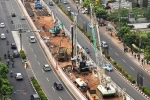National Strategic Project: State Budget lends support to high-speed train
This article has been translated by PwC Indonesia as part of our Indonesia Infrastructure News Service. PwC Indonesia has not checked the accuracy of, and accepts no responsibility for the content.
Bisnis Indonesia - Proyek Strategis Nasional: Ada APBN di Balik Kereta Cepat
12 October 2021
By: Hendra Wibawa
PT Kereta Cepat Indonesia China’s wish to complete Jakarta-Bandung high-speed railway project without funding complications is within reach.
Moreover, the management of PT Kereta Cepat Indonesia China (KCIC) that is working on the national strategic project has received significant support from the government after the issuance of Presidential Regulation Number 93 of 2021 on Amendment to Presidential Regulation Number 107 Year 2015 Regarding Acceleration of Infrastructure and Facilities Organization of High-Speed Railway Between Jakarta and Bandung.
In the Presidential Regulation, the Jakarta-Bandung High-Speed Railway project can be funded by the state budget. In the newest regulation, President Joko Widodo also appoints Coordinating Minister for Maritime Affairs and Investment, Luhut B. Pandjaitan, as the Jakarta -Bandung High-Speed Railway Committee Chairperson who will coordinate the government’s support to handle cost overrun, in line with the laws.
Special Staff for SOE (State-owned Enterprise) Minister, Arya Sinulingga, explained that the issuance of the Presidential Regulation affirmed the government’s wish to complete the construction of Jakarta-Bandung High-Speed Railway on time by 2022.
He said that the Covid-19 pandemic had made the cashflow of shareholders in the SOE consortium, such as PT Wijaya Karya Tbk (WIKA), to be disturbed. Hence, WIKA struggles to complete other construction projects. Not only WIKA, the performance of PT Kereta Api Indonesia (KAI) also declined after being hit by the Covid-19 pandemic, so the state-owned railway company struggles to provide the funds that has been previously planned. A similar fate also befell PT Jasa Marga Tbk (JSMR) and PT Perkebunan Nusantara (PTPN) VIII.
“These are what force the government needs to be involved in providing the funding, so the high-speed train can be excellently carried out, so” he said last weekend.
Arya reckoned that the cost overrun of Jakarta-Bandung High-Speed Railway was normal as the project was delayed. The project’s delay increased the cost.
He said that the exact amount of the cost increase of the cooperation project with the Chinese government was still waiting for the audit result.
The audit result will disclose the cost increase from land acquisition and design changes due to geographical and geological conditions.
“So, we, from the SOE Ministry, is already asking for BPKP (Development Finance Comptroller) to conduct an audit,” he said.
According to him, an audit must be conducted to determine the amount of funds required to complete the high-speed railway project.
He also affirmed that the high-speed railway project was required by Indonesia to be a modern country such as other countries all over the world. This is the main consideration of President Joko Widodo when he agreed to construct the high-speed railway.
On a separate occasion, KCIC Corporate Secretary, Mirza Soraya, welcomed the issuance of Presidential Regulation Number 93 of 2021. According to him, KCIC’s priority is to accelerate construction and pursue the lack of progress due to the Covid-19 pandemic.
“Our current focus is to accelerate construction so that the operational target at the end of 2022 can be realised,” he said on Monday (11/10).
According to him, KCIC is focusing on completing three tunnels and the erection girder to construct the elevated tracks from Batununggal Bandung to Tegalluar.
Moreover, KCIC is also focusing on finishing constructions in Karawang and Purwakarta, which include stations.
Regarding facilities and infrastructure, Mirza explained that they had entered production at CRRC factory in China.
The Jakarta-Bandung High-Speed Railway project is planned to use the EMU CR400AF technology, so it can accelerate up to 400 km per hour. However, Mirza affirmed that the train will only operate at 350 km per hour.
In determining the speed, there are several aspects considered, such as the facility’s capability, the type of track, the geometry of the tracks, and the operating facility capability.
Besides previous considerations, the number of stations along Jakarta-Bandung High-Speed Railway’s route also refers to China Code for Design of High-Speed Railway.
Regarding the cost overrun, he handovers the calculation and the audit on the cost overrun of the project to shareholders. “The funding policy and other aspects regarding investments as well as the cost overrun are under the jurisdiction of the government and the sponsoring SOEs,” Mirza said.
He said that KCIC also needed to prepare the operation and the human resources, the operating system, as well as the discussion and the harmonisation with the Transportation Ministry.
Until the fourth week of September 2021, the progress of the project worked on by KCIC had reached 79%. With the progress, KCIC is prioritising to accelerate construction and pursue the lack of progress due to the Covid-19 pandemic.
Creative funding
Meanwhile, Institute of Transportation Studies (Instran), Deddy Herlambang, reckoned that it was unfortunate that the government funded the Jakarta-Bandung High-Speed Railway using the state budget.
Deddy explained that the key to complete the cooperation project with China was the capital. It is not surprising that it was delayed several times as the SOE consortium does not possess sufficient capital.
According to him, the government’s policy to provide financing using the state budget is a political way to accelerate a project.
He suggests that the government should continue looking for creative funding to fund the national strategic project, such as by appointing a new consortium member from banks, both local/SOE or foreign banks, to guarantee or even to fund the project. Moreover, the area development business is more beneficial thanks to the transit-oriented development (TOD) scheme.
Deddy also suggests KCIC to learn from the unsuccessful airport train project in Soekarno-Hatta Airport and South Sumatra Light Rail Transit (LRT) that lacks passengers despite being physically integrated with other transportation modes.
Deddy reckoned that building a transportation needed more than just facilities and infrastructure, but also its potential users.
He predicts that the segment that will use Jakarta-Bandung High-Speed Railway are citizens who live in a 10-kilometre radius from Halim Station. Citizens in Central Jakarta, North Jakarta, and Bogor will prefer using their private vehicles to go to Bandung.


















